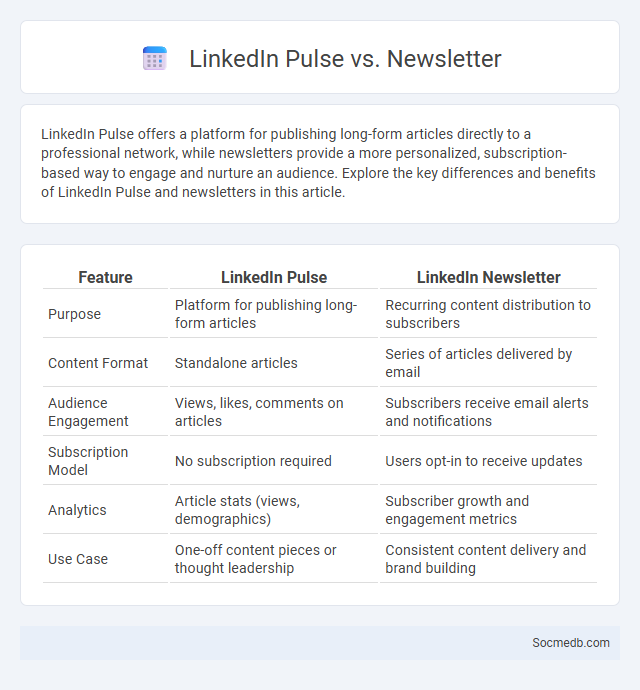
Photo illustration: LinkedIn Pulse vs Newsletter
LinkedIn Pulse offers a platform for publishing long-form articles directly to a professional network, while newsletters provide a more personalized, subscription-based way to engage and nurture an audience. Explore the key differences and benefits of LinkedIn Pulse and newsletters in this article.
Table of Comparison
| Feature | LinkedIn Pulse | LinkedIn Newsletter |
|---|---|---|
| Purpose | Platform for publishing long-form articles | Recurring content distribution to subscribers |
| Content Format | Standalone articles | Series of articles delivered by email |
| Audience Engagement | Views, likes, comments on articles | Subscribers receive email alerts and notifications |
| Subscription Model | No subscription required | Users opt-in to receive updates |
| Analytics | Article stats (views, demographics) | Subscriber growth and engagement metrics |
| Use Case | One-off content pieces or thought leadership | Consistent content delivery and brand building |
Introduction to LinkedIn Pulse and Newsletters
LinkedIn Pulse is a powerful platform for professionals to share insights, industry news, and thought leadership through articles and posts tailored to your network. Newsletters on LinkedIn Pulse enable you to build a dedicated audience by delivering consistent, valuable content directly to subscribers' inboxes, boosting your influence and engagement. Leveraging these tools enhances your professional brand and fosters meaningful connections within your industry.
What is LinkedIn Pulse?
LinkedIn Pulse is a content publishing platform integrated into LinkedIn that allows professionals to share original articles and industry insights directly with their network. It enables users to amplify their personal brand by reaching a targeted audience of peers, recruiters, and potential clients. By leveraging LinkedIn Pulse, you can increase your visibility and establish thought leadership within your professional community.
Understanding LinkedIn Newsletters
LinkedIn Newsletters offer professionals a powerful platform to share industry insights, build thought leadership, and engage a targeted audience through regular email updates. These newsletters leverage LinkedIn's network effects, enabling content creators to expand reach by allowing subscribers to receive notifications and share content easily. Utilizing analytics tools provided by LinkedIn helps optimize newsletter performance by monitoring open rates, subscriber growth, and engagement metrics.
Content Distribution: Pulse vs Newsletter
Content distribution through Pulse and newsletters serves distinct purposes in social media strategy. Pulse enables real-time engagement by delivering trending articles directly to users, maximizing content visibility and interaction. Newsletters provide targeted, personalized content to a subscribed audience, fostering deeper connections and sustained user loyalty.
Audience Engagement Comparison
Audience engagement on social media varies significantly across platforms, with Instagram boasting an average engagement rate of 1.22%, outperforming Facebook's 0.08% and Twitter's 0.045%. Instagram's visual-centric format enhances user interaction through likes, comments, and shares, while Twitter's fast-paced environment limits sustained engagement. Facebook maintains a broader demographic reach but experiences lower engagement rates due to algorithm changes and content saturation.
Visibility and Reach on LinkedIn
LinkedIn enhances visibility by leveraging professional networks and industry-focused content, allowing users to connect with targeted audiences and decision-makers effectively. The platform's algorithm prioritizes engagement and relevance, boosting post reach among professionals within specific sectors and roles. Utilizing LinkedIn's tools such as hashtags, groups, and sponsored content increases exposure, driving higher interaction rates and expanding brand presence in the B2B landscape.
Pros and Cons of LinkedIn Pulse
LinkedIn Pulse offers professionals a powerful platform to share industry insights, build personal brands, and connect with targeted audiences, enhancing career growth and networking opportunities. However, content visibility can be limited due to LinkedIn's complex algorithm, and the platform may attract overly promotional or less engaging posts, reducing content quality. Users must balance leveraging Pulse's professional exposure with the effort required to maintain consistent, high-quality posting to maximize benefits.
Advantages and Limitations of Newsletters
Newsletters on social media platforms provide targeted content delivery, enhancing audience engagement and fostering brand loyalty through personalized updates and exclusive offers. They enable direct communication with subscribers, increasing conversion rates and allowing precise tracking of user behavior through analytics. However, newsletters face limitations such as potential spam filters reducing reach, the challenge of maintaining subscriber interest, and the need for continuous content creativity to avoid audience fatigue.
Choosing the Best Format for Your Content Strategy
Selecting the best format for your social media content strategy hinges on understanding your target audience's preferences and the platform's algorithmic strengths. Visual formats like videos and images often generate higher engagement on platforms like Instagram and TikTok, while detailed articles and infographics perform well on LinkedIn and Facebook. Tailoring your content type not only maximizes reach but also boosts interaction and conversion rates.
Conclusion: Pulse or Newsletter—Which Suits Your Goals?
Choosing between a social media pulse update and a newsletter depends on your audience engagement goals and content delivery frequency. Social media pulses offer immediate, brief interactions ideal for real-time updates and fostering quick community feedback. Newsletters provide a structured format for detailed, curated content, suitable for building brand loyalty and delivering in-depth information directly to subscribers.
 socmedb.com
socmedb.com